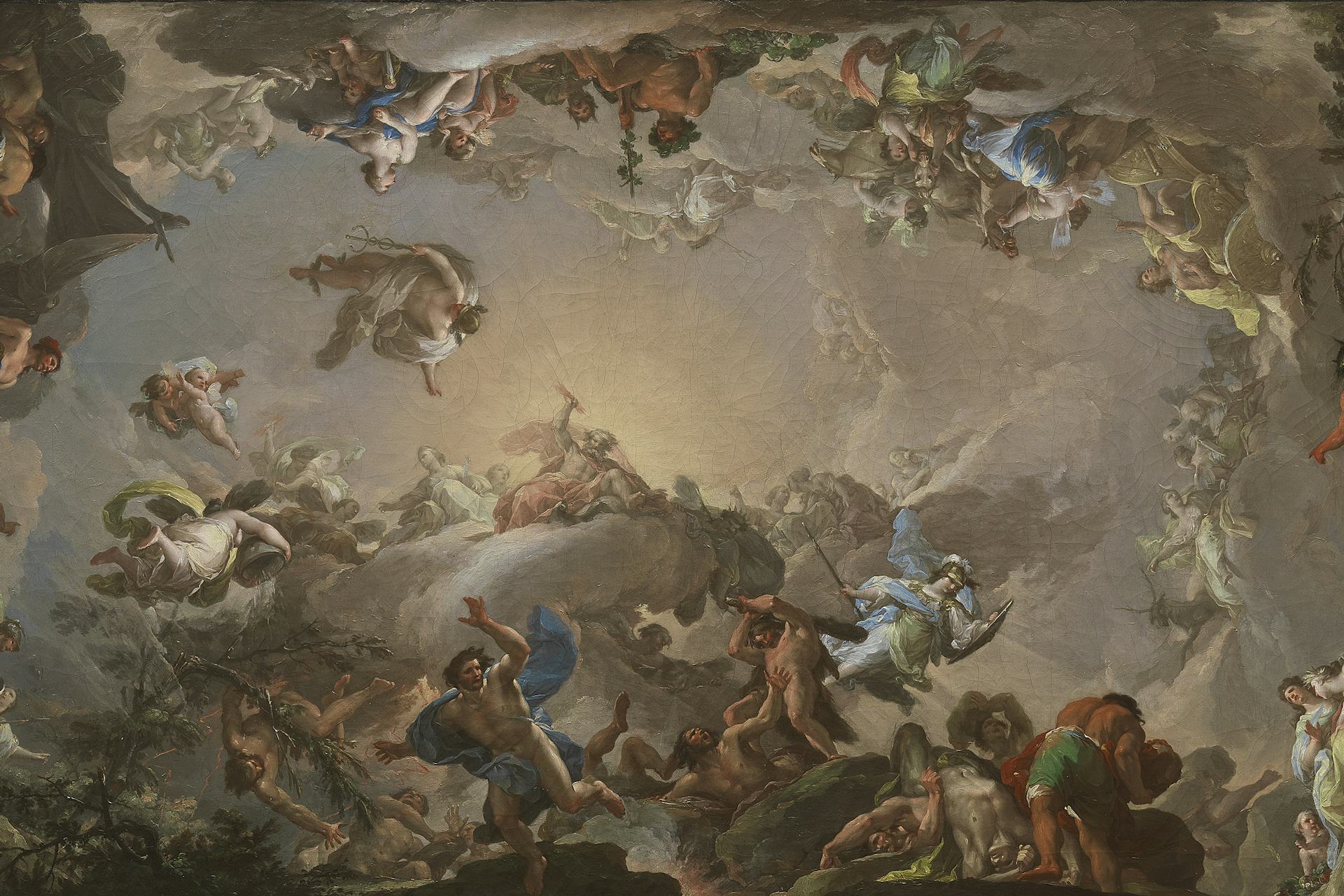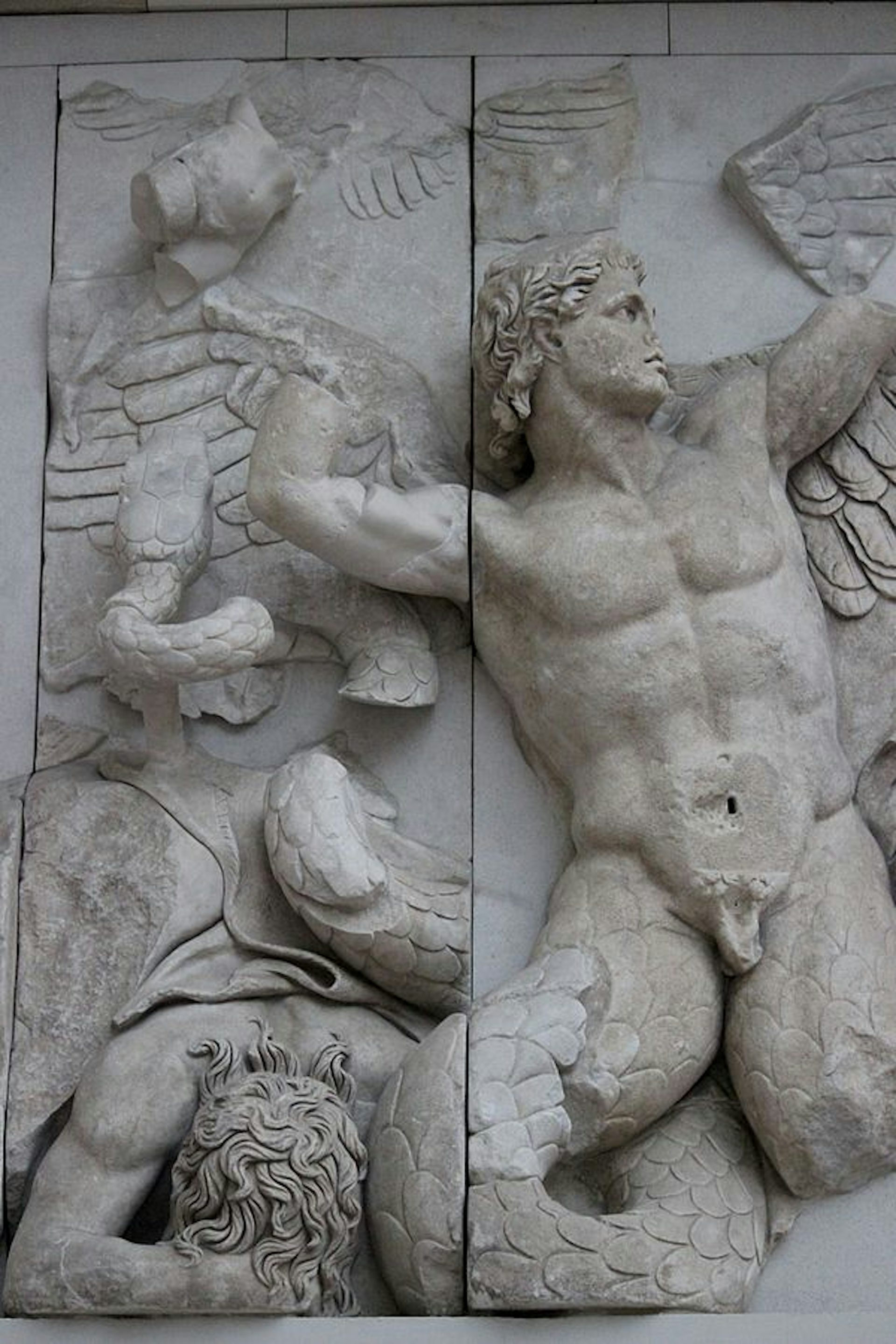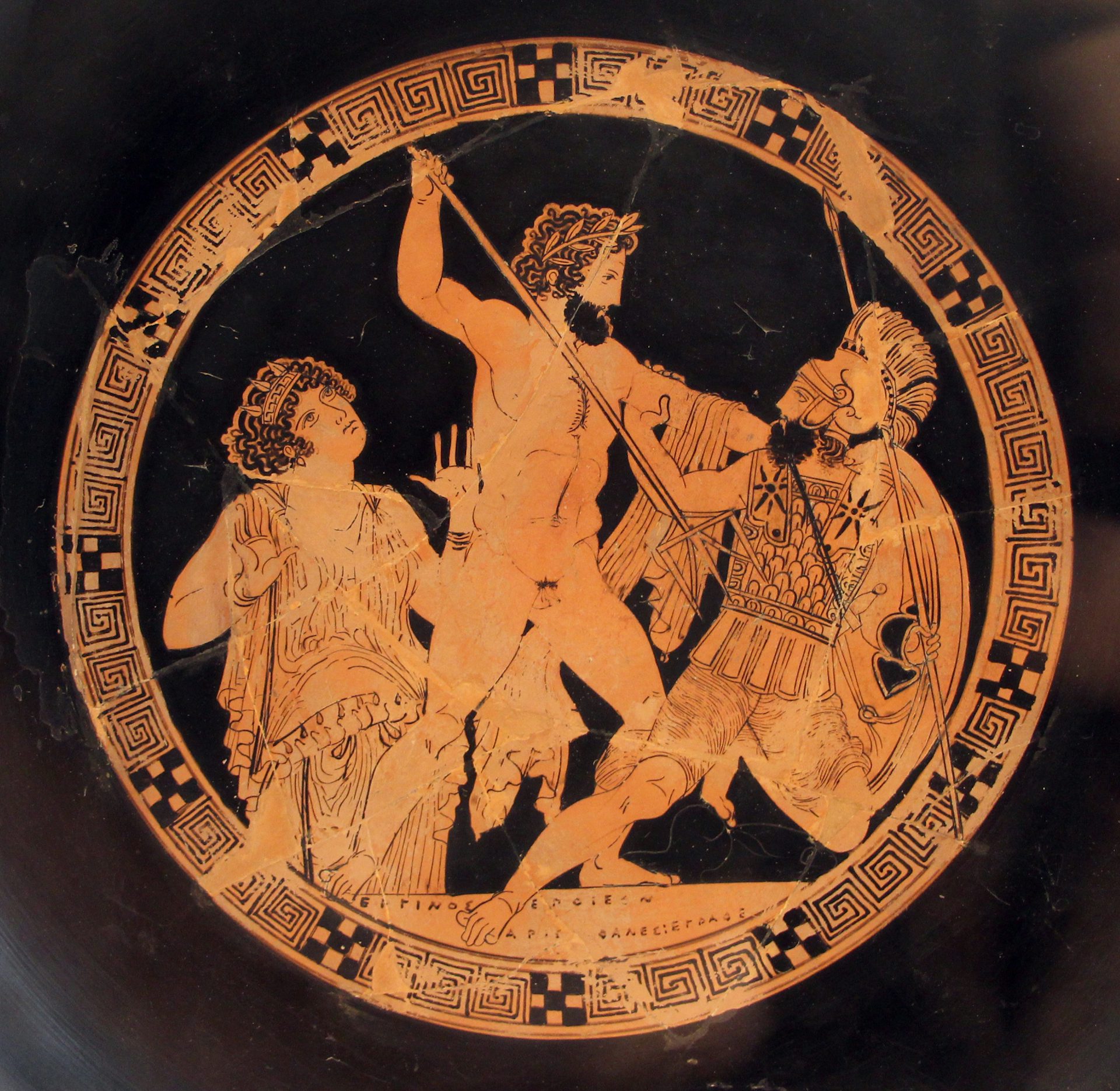Giants

Olympus: The Fall of the Giants by Francisco Bayeu y Subías (1764)
Prado Museum, MadridPublic DomainOverview
The terrible Giants, offspring of the primordial earth goddess Gaia, were a race of fierce and powerful monsters. Often represented as large creatures with serpents in place of legs, the Giants fought Zeus and the other Olympian gods in a war known as the Gigantomachy.
According to a prophecy, the Olympians could only defeat the Giants with the aid of a mortal, so they recruited Heracles, the strongest of all mortal heroes, to their side. With Heracles’ help, the Olympians were able to crush the Giants and maintain their power over the cosmos.
The Giants and the Gigantomachy were extremely important subjects in Greek mythology and were often depicted in Greek literature and art. By the Classical period, the Giants’ defeat in the Gigantomachy was typically interpreted as representing the triumph of civilization over barbarism.
Etymology
In antiquity, the term “Giant” (Greek Γίγας, translit. Gígas; pl. “Giants,” Greek Γίγαντες, translit. Gígantes) was thought to mean “earth-born,” which reflected the creatures’ status as children of Gaia (“Gaia” or “Ge” was the goddess of the earth, but also a word for the earth itself).
Modern scholars, however, are less sure about the origins of the term; no satisfactory Indo-European etymology has yet been proposed. One interesting (albeit highly tentative) idea is that the name comes from the Semitic root gg, meaning “roof” or “top,” potentially suggesting great height; the Greek word for “Giant” may thus be related to the names of Old Testament “giants” such as Og or Gog.[1]
Pronunciation
English
Greek
Giant, Giants Γίγας, Γίγαντες (Gígas, Gígantes) Phonetic
IPA
[JAHY-uhnt], [JAHY-uhnts] /ˈdʒaɪ ənt/, /ˈdʒaɪ ənts/
Titles and Epithets
The term “Giant” is the usual translation of the Greek “Gigas” (plural “Gigantes”). However, some modern sources prefer to use the transliterated Greek form of the word, calling them “Gigantes” rather than “Giants.”
The epithets of the Giants—both as a group and individually—tended to reflect their strength and brutality. Individual Giants such as Eurymedon, for example, were sometimes described as μεγαλήτωρ (megalḗtōr), “great-hearted,” or ἀτάσθαλος (atásthalos), “reckless.” Collectively, the Giants were referred to as κρατεροί (krateroí), “strong,” and μεγάλοι (megáloi), “large.” The Giants (along with other mythological beings) were also commonly described as γηγενής (gēgenḗs), “earth-born,” a reference to their origins from the earth goddess Gaia.
Attributes
General
The Giants were usually seen as large, strong creatures, born not long after the cosmos came into existence. It is not clear whether they were “giants” in the contemporary sense of “extremely tall”; some sources did represent them this way, but not all. Like centaurs and satyrs, Giants were always male.
Representations of the Giants evolved throughout antiquity. Hesiod, the earliest source to describe the origins and appearance of the Giants, wrote that they wore “gleaming armor” and held “long spears in their hands.”[2] One later source went so far as to say that the Giants were born from the ground fully armed.[3]
In most early artistic and literary sources (like Hesiod), the Giants were seen as largely anthropomorphic—that is, their appearance was no different from that of ordinary mortals, except perhaps for the fact that they were stronger and more imposing than the average man. Typically they were shown heavily armed, similar to the Greek soldiers known as hoplites.
But the Giants eventually assumed a more monstrous appearance. According to Apollodorus, a writer who lived some seven centuries after Hesiod, the Giants were exceptionally large, strong creatures, with long hair and beards and scaly serpents for legs; they fought by hurling boulders and uprooted trees.[4] One writer described the Giants as snake-haired;[5] another (probably confusing the Giants with the Hecatoncheires) claimed that they had a hundred arms each.[6] Rarely, the Giants were even depicted as beasts such as lions or bulls (see below).[7]

Northern frieze from the Siphnian Treasury at Delphi (ca. 525 BCE) showing the Gigantomachy. The Giants are represented as hoplites.
National Archaeological Museum, Delphi / ZdeCC BY-SA 4.0Homer, the earliest source to mention the Giants, tells us that they were ruled by a king named Eurymedon.[8] But Homer’s Giants were not necessarily the same as the Giants found in Hesiod and other later sources, even if they share some qualities (such as violence). At any rate, all Homer says of his “Giants” is that they were powerful, arrogant creatures who lived near the Phaeacians and the Cyclopes (probably off the coast of western Greece), and that they were eventually destroyed by the gods.[9]
Though Homer’s Giants seem to have lived somewhere in the West, most sources claimed that they came from the East—from the town of Phlegrae or Pallene in Thrace.[10] Likewise, most sources contradicted Homer by listing Porphyrion (not Eurymedon) as commander of the Giants,[11] with Alcyoneus sometimes said to rule alongside him.[12] Porphyrion and Alcyoneus were the strongest of the Giants.
The Giants were known for their savagery and impunity. As early as Homer, they were described as “insolent” and “froward.”[13] For the poet Bacchylides, the Giants’ defining characteristic was their hybris—that is, their defiant insolence, or “hubris.”[14] By the Classical period (ca. 490–323 BCE), the Greek term “gigas” seemed to connote large size, strength, and impiety.[15]
The Giants were interpreted in different ways throughout antiquity. They were commonly seen as an example of what happened to those who challenged the rule of Zeus and the Olympian gods, or as symbols of barbarism happily defeated by the forces of civilization. But some rejected the myth of the Gigantomachy on the grounds that it represented the gods in an impious and unethical manner.[16]
In later periods, the role of the Giants became more confused. Some authors tried to rationalize the Giants, taking away their monstrous attributes and transforming them instead into arrogant mortals who enslaved those around them and challenged the gods. Roman authors, meanwhile, tended to conflate the Giants with other fearsome opponents of the Olympian gods, including the Titans and the Aloads.
Iconography
Beginning in the early to mid-sixth century BCE, the Giants and their war against the gods (the Gigantomachy) became extremely popular subjects in ancient Greek art. The Greek travel writer Pausanias mentions that a battle between Heracles and a Giant appeared among the lavish decorations of the Amyclae Throne, an important piece of monumental art from the end of the sixth century BCE.[17]
Other important artistic examples of the Giants and the Gigantomachy include the northern frieze of the Siphnian Treasury at Delphi (ca. 525 BCE), the eastern metopes of the Parthenon (ca. 445/440 BCE), and the painting on the interior of the shield of the statue of Athena Parthenos that once stood in the Parthenon (ca. 438 BCE).
But probably the most spectacular example of the Gigantomachy in ancient art comes from the Pergamon Altar (180/160 BCE). On this monumental frieze, serpent-footed Giants are shown in battle with the Greek gods, many of whom are named on inscriptions.

Detail from the frieze of the Pergamon Altar (ca. 180/160 BCE), showing a serpent-footed Giant
Pergamon Museum, Berlin, Germany / Miguel Hermoso CuestaCC BY-SA 4.0These depictions often set out to illustrate the superiority of order and civilization (symbolized by the gods) over chaos and barbarism (symbolized by the Giants). Such iconography became increasingly popular in the fifth century BCE, after the wars between the Greeks and the “barbaric” Persians.
The Giants themselves were originally represented as warriors armed like hoplites, with breastplates, helmets, and round shields. But from about 400 BCE on, they were more commonly shown as serpent-legged (or, more rarely, fish-legged); sometimes they also had serpents sprouting from their hips and shoulders or mixed into their hair. On the Pergamon Altar, some of the Giants were represented in the form of wild animals such as birds, lions, or bulls.
Giants and Gigantomachies maintained their popularity in Roman art; examples can be found in architectural sculpture, painting, and mosaic.[18]
Family
The Giants were children of Gaia, the goddess of the earth. In the most familiar account, they were born after the blood of the sky god Uranus fell upon the earth, inseminating Gaia.[19] But according to Hyginus, Gaia had the Giants with Tartarus, a primordial god of the deepest part of the Underworld.[20]
In the common tradition, the Giants were born together with the Erinyes (the “Furies”) and the Meliae (obscure nymphs connected with ash trees). But their siblings also included Gaia’s many children from her other unions—among them, the Cyclopes, the Hecatoncheires, and the Titans.
For the most part, the Giants seem to have died without leaving behind any children, but there are a few exceptions. For instance, Eurymedon, the king of the Giants mentioned by Homer, had a daughter named Periboea, to whom the Phaeacians traced their ancestry.[21] Otherwise, the Giants were generally not known to marry and start families.
In one source, a race of human beings was born from the blood of the Giants after they died in battle against the gods.[22]
Mythology
Origins
The myth of the Giants and their war with the gods is very ancient. It most likely emerged alongside other myths that tell of challenges to the Olympians’ authority, such as Zeus’ defeat of the Titans or the battle between Zeus and Typhoeus. Like these other stories—which all deal with Zeus’ consolidation of his power over the cosmos—the Giants’ mythos may have been influenced by Near Eastern lore.
The Greeks sometimes sought natural explanations for the myth of the Giants, connecting it, for instance, with volcanic eruptions.[23] The myths of the large and powerful Giants may have also been inspired in part by the fossilized bones of large prehistoric animals, which were sometimes discovered by the ancient Greeks and interpreted as the remains of the mythical Giants.[24]
In myth, the tale of the Giants begins at the dawn of creation. Gaia, one of the first beings to come into existence, had taken as her mate Uranus, the god of the sky. The couple had numerous powerful children together—most notably, the Hecatoncheires, or “Hundred-Handers” (known for the one hundred powerful arms they each wielded), the one-eyed Cyclopes, and the Titans.
But Uranus proved a cruel father, imprisoning and mistreating his children until they rose up against him. Cronus, the youngest of the Titans, was given an adamant sickle by his mother Gaia, which he used to castrate Uranus. The blood that spilled from Uranus’ wounds fell upon the earth and impregnated Gaia. According to Hesiod:
… as the seasons moved round she [Gaia] bore the strong Erinyes and the great Giants with gleaming armour, holding long spears in their hands and the Nymphs whom they call Meliae all over the boundless earth.[25]
The Gigantomachy
Provocations
The most important myth of the Giants was the tale of the Gigantomachy—the terrible war waged between the Giants and the gods of Olympus. There were different explanations for the origins of this war.
Early texts are rather vague about what led to the battle and the destruction of the Giants. According to Homer, the Giant Eurymedon brought ruin upon himself by somehow offending the gods (we are not told his exact crime).[26] The fifth-century BCE poet Pindar similarly says that the Giant Porphyrion acted inappropriately,[27] while Bacchylides (a contemporary of Pindar) says that the Giants were destroyed because of their hybris.[28]
Later sources offer more detailed information on what caused the Gigantomachy. In one account, hostilities began when the Giant Alcyoneus stole the cattle of Helios from his sacred island of Thrinacia.[29] In another account, the Giants’ king, Eurymedon, slept with Hera (or raped her) before she married Zeus, causing her to give birth to Prometheus.[30] After Zeus married Hera, he put Prometheus in chains on a flimsy pretext and cast Eurymedon into Tartarus.[31]
But in what has become the best-known tradition, Gaia sent the Giants against the Olympians to punish them for overthrowing the Titans.[32] Goaded on by their mother, the Giants set out to unseat Zeus and the Olympians and seize their power.
Preparations
As the Giants were mobilizing, the gods learned from an oracle that the Giants could only die at the hands of a mortal. They therefore sent for Heracles, the most impressive mortal hero, to join them in their struggle (in another version, the gods were told to seek the help of two demigods—Heracles and Dionysus).[33]

The "Farnese Hercules" by Glycon of Athens (early 3rd century CE)
National Archaeological Museum, Naples / Marie-Lan NguyenCC BY 2.5But Gaia had also learned of the prophecy, and she caused a plant to grow that would prevent the Giants from being killed even by a mortal. Zeus responded with a trick of his own: he ordered the sun and moon not to shine, then harvested the plant for himself before anyone else could get to it.[34]
The Battle Site
The location of the battle between the gods and the Giants was an item of controversy in antiquity. In the most common tradition, the fighting took place at Phlegrae or Pallene, the town in Thrace where the Giants had been born (the two names are usually interchangeable).[35] But there was a variant tradition in which the battle took place at the Phlegraean Fields in Italy, not far from Naples.[36] Others said that the battle was fought on the island of Ischia, off the western coast of Italy;[37] on the plains of Megalopolis in Arcadia;[38] in Tartessus, a region of Spain;[39] or in the Black Sea town of Phanagoria (among other suggestions).
The Battle
When the war at last began, the Giants were led (in most accounts) by Porphyrion and Alcyoneus. On the side of the gods, it was Zeus, Heracles, Athena, and Poseidon who most actively participated in the fighting.
According to Apollodorus, the battle commenced with a face-off between Heracles and Alcyoneus. Heracles shot Alcyoneus down with an arrow, only to discover that the Giant recovered his strength whenever he touched the soil of Pallene, where he had been born. Thus, Heracles dragged Alcyoneus away from Pallene and killed him again (this time for good).[40]
The battle then seems to have devolved into a series of individual combats. According to Apollodorus, Apollo and Heracles killed Ephialtes, each of them shooting him in one of his eyes;[41] Dionysus used his thyrsus to kill Eurytus; Hecate killed Clytius with torches; Hephaestus killed Mimas, shooting him with missiles of heated metal;[42] Athena killed Enceladus by throwing the island of Sicily on top of him,[43] then flayed Pallas and used his skin as armor; Poseidon broke off a piece of the island of Cos and used it to kill Polybotes (this broken piece became the small isle of Nisyros);[44] Hermes, wearing Hades’ helmet of invisibility, killed Hippolytus; Artemis killed Gration (or perhaps Gaion or Eurytion); and the Moirae killed Agrius and Thoon with bronze clubs.
Porphyrion, the strongest of the Giants, seems to have presented a more serious challenge. Zeus was finally able to distract him by inspiring him with an irresistible lust for Hera, Zeus’ own wife. As Porphyrion tried to force himself on Hera, Zeus struck him with a lightning bolt, while Heracles shot him with an arrow.[45] In fact, Heracles shot each of the Giants as they fell for good measure.[46]
There were other accounts of the battle, some of which added colorful details to the story. According to Diodorus of Sicily, for example, the Gigantomachy actually comprised three battles that took place at Pallene, the Phlegraean Fields in Italy, and the island of Crete.[47] The Roman poet Claudian wrote that during the battle, Athena changed her opponents into stone using the head of the Gorgon Medusa.[48] In one account, the gods had the help of the Hecatoncheir Briareus (also called Aegaeon),[49] while in another the Giants received help from a Gorgon.[50] Some artistic representations of the battle show Gaia standing before the gods, apparently in an abortive attempt to beg them to spare her children.

Attic red-figure kylix, signed by Aristophanes and Erginus (ca. 410 BCE) showing Poseidon (center) killing the Giant Polybotes (right) with his trident as Gaia kneels behind him, pleading with him to spare her son’s life (left). From Vulci.
State Museum (Antikensammlung), Berlin / sailkoCC BY 3.0Aftermath
At last, the Giants were defeated, and the Olympians retained their rule over the cosmos. Heracles, as thanks for his help, was turned into a god after he died. Gaia naturally only grew angrier, and in some traditions she continued devising plots to try to overthrow Zeus and the Olympians.
The Giants themselves were shown no mercy. They were either killed or buried beneath volcanoes, whose rumblings and eruptions were said to be caused by the writhings of the Giants as they struggled to get free.[51] But in some traditions, certain Giants were able to escape the slaughter and sought refuge in various parts of the world.[52]
According to one account, found in Ovid’s Metamorphoses, Gaia caused a new race of human beings to rise from the blood of the fallen Giants.[53]
Pop Culture
Already in antiquity, it was not uncommon to confuse the Giants with other mythological opponents of the gods, especially the Titans. Over time, the words “giant” and “titan” came to designate any creature that was exceptionally large and tall—though this was not necessarily the meaning of these words for the ancient Greeks.
As a result, the Giants of today’s pop culture are very different from the Giants of antiquity. They tend to be conflated with other Greek mythological creatures (like the Titans) and are commonly depicted simply as large humans (the serpent legs of Apollodorus, the Pergamon Altar, and many other sources are all but forgotten).
When the Giants do appear in contemporary adaptations of Greek mythology, they often reprise their original role as opponents of the Olympian gods. For example, the Giants are highly important in Rick Riordan’s The Heroes of Olympus series (where they are called “Gigantes”); in this version, each of the Giants has been born to oppose one specific god.